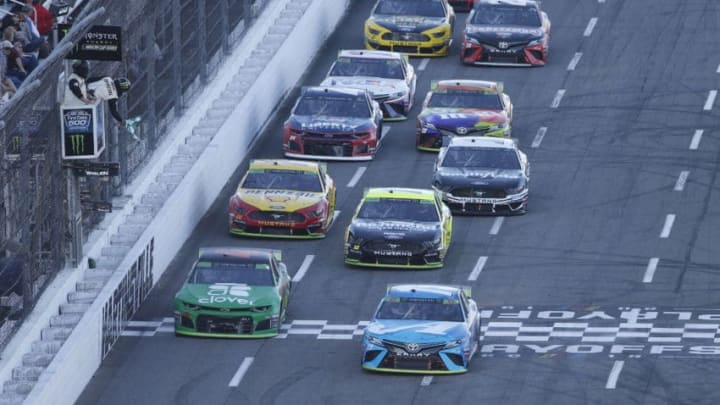NASCAR Cup Series: Can short track racing be revived?
By Asher Fair

In 2019 with the new rules package, NASCAR Cup Series short track racing was a disaster. Can what was once spectacular racing be revived moving forward?
The 2019 NASCAR Cup Series season saw the introduction of a new rules package that, for the most part, increased the competitiveness and the excitement of the racing across the board.
Factoring in each and every one of the 36 races that took place last year, there was not a single major metric that did not improve from 2018 to 2019.
However, if you break down the 36-race schedule into track types, you’ll find that even amid the major improvement, short track racing held the overall improvement back.
In fact, short track racing was almost unspeakably worse in 2019 than it was in 2018, to the point where the most interesting “short track racing” moment of the season was probably this right here.
Take a listen to what @dennyhamlin had to say following his altercation with @joeylogano on pit road. #NASCARPlayoffs pic.twitter.com/hihRxrlawr
— NASCAR (@NASCAR) October 27, 2019
While NASCAR has stated multiple times that the 2020 rules would not be altered as a whole, NASCAR president Steve Phelps stated right around the time the 2019 season ended that short track racing needed quite a bit of work.
Here is what he had to say, according to USA Today.
"“Our competition right now on the intermediate tracks and the superspeedways I believe is the best racing we’ve ever seen. Do I think we need to work…to improve what we’re seeing on the short tracks? I do. We’re going to do that in the offseason, for sure.”"
But how much work is needed?
A lot.
For the sake of this article, short tracks are considered tracks that are less than (not less than or equal to) one mile in length. As such, they include only Martinsville Speedway, Bristol Motor Speedway and Richmond Raceway, three tracks that each hosted two races in the 2019 season.
More from NASCAR Cup Series
- NASCAR Cup Series: New team set to compete in 2024
- NASCAR: Surprising name continuously linked to new seat
- NASCAR driver at risk of missing the Daytona 500?
- NASCAR set for rare appearance last seen 13 years ago
- NASCAR team adds third car, names driver for 2024 Daytona 500
Take a look at three basic racing metrics for these tracks in 2018 and 2019: green flag passes, lead changes and winning margin.
In 2019, only one of these six short track races saw a higher average number of green flag passes per lap than in 2018, and it was only a slight increase. The March race at Martinsville saw this metric increase from 2.1 to 2.2.
Meanwhile, the decreases among the other five races were all greater. The April race at Bristol saw this metric decrease from 4.5 to 4.3 while the August race at the track saw it decrease from 4.6 to 3.8. As for Richmond Raceway, the April race saw it decrease from 5.1 to 3.4 and the September playoff race saw it decrease from 4.4 to 2.7. The other race at Martinsville, the October playoff race, saw it drop from 3.0 to 2.8.
Lead changes increased for both Bristol races, but for the Martinsville and Richmond races, this metric decreased significantly.
The April and August Bristol races went from 18 to 21 and 19 to 23, respectively. But after featuring 11 lead changes in each race for a total of 22 in 2018, Martinsville featured just three in each for a total of six in 2019 — and four of those six only happened because of pit strategy.
Richmond was almost just as disastrous; after featuring 16 lead changes in each race for a total of 32 in 2018, it featured just 14 total in 2019, with eight in April and six in September.
Finally, only two of the six short track races, the March race at Martinsville and the April race at Richmond Raceway, saw closer finishes in 2019 than they did in 2018.
The 2019 April race at Bristol was also the only race to feature a winning starting position lower than that of 2018 among short track races, but that can be chalked up to more than just a subpar racing product. A lot can happen over several hundred laps, no matter how hard it is to pass.
But it’s not all gloom and doom moving forward for some of NASCAR’s most beloved venues.
Fortunately, NASCAR has made changes for 2020, and for more than just these three short tracks. Based on what these changes are, this could be a whole lot more than a “step in the right direction”, too.
A new low downforce package was introduced just last month for the six tracks that are one mile in length or less along with the three road courses, and it should result in a lot closer racing with a lot more passing, including lead changes.
Bristol Motor Speedway, Dover International Speedway, Martinsville Speedway, New Hampshire Motor Speedway, Phoenix Raceway and Richmond Raceway are these six ovals and Sonoma Raceway, Watkins Glen International and the Charlotte Motor Speedway roval are the three road courses.
In total, these nine tracks are slated to host 14 races on the 36-race schedule, so the effects of this new package should be huge.
Next. Top 10 NASCAR drivers of all-time. dark
Will NASCAR Cup Series short track racing improve in the 2020 season? The 2020 schedule does look a bit different than the 2019 schedule, so make note of that moving forward. The first official short track race of the season (based on the standards of the new package) is the FanShield 500 at Phoenix Raceway. This race is scheduled to take place on Sunday, March 8.